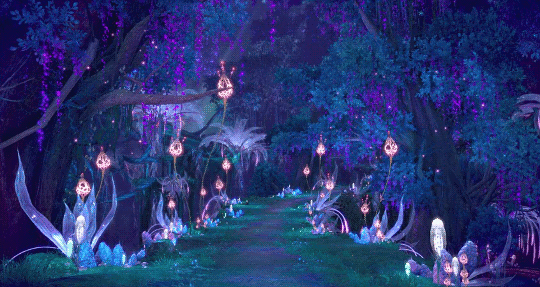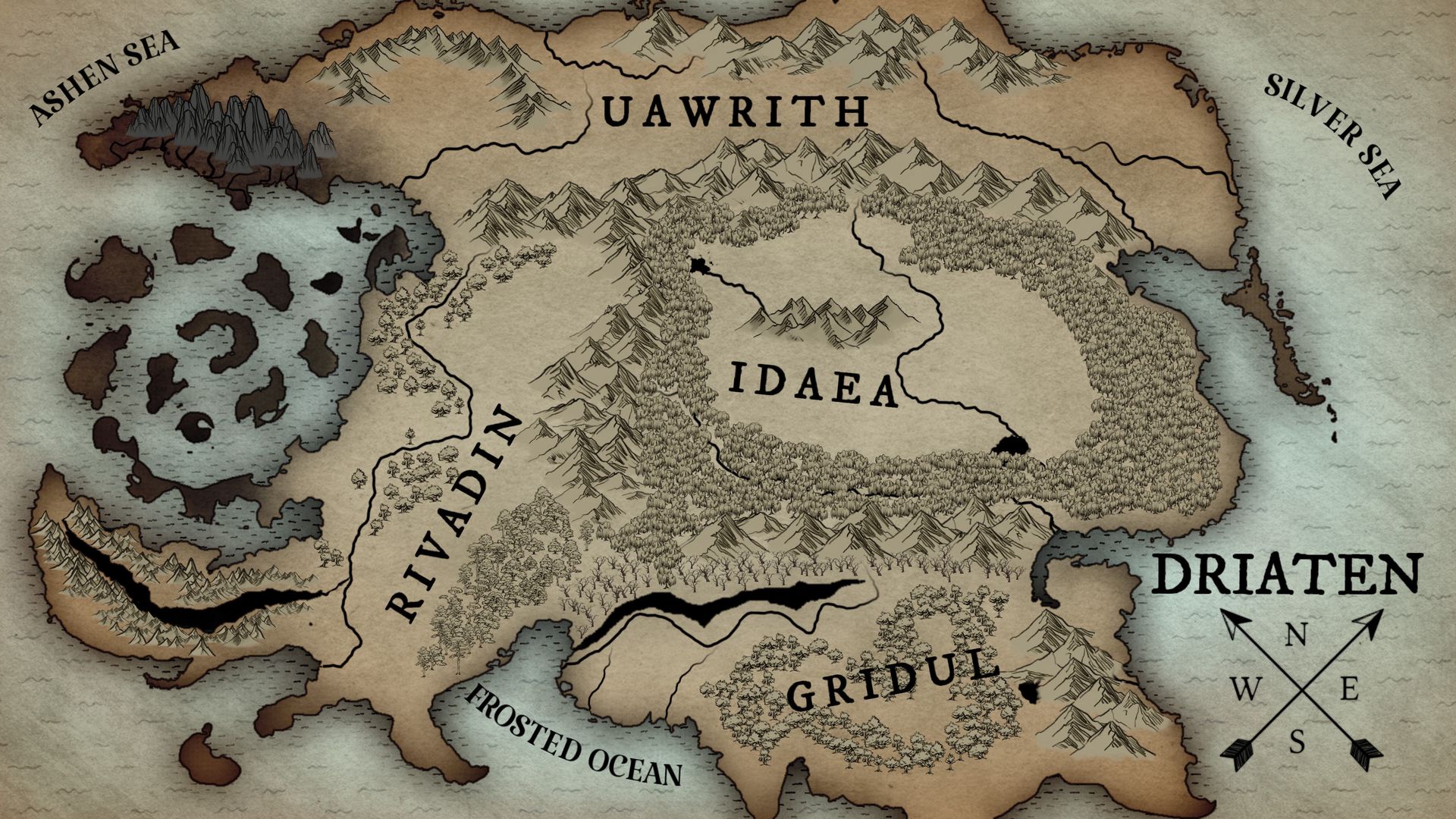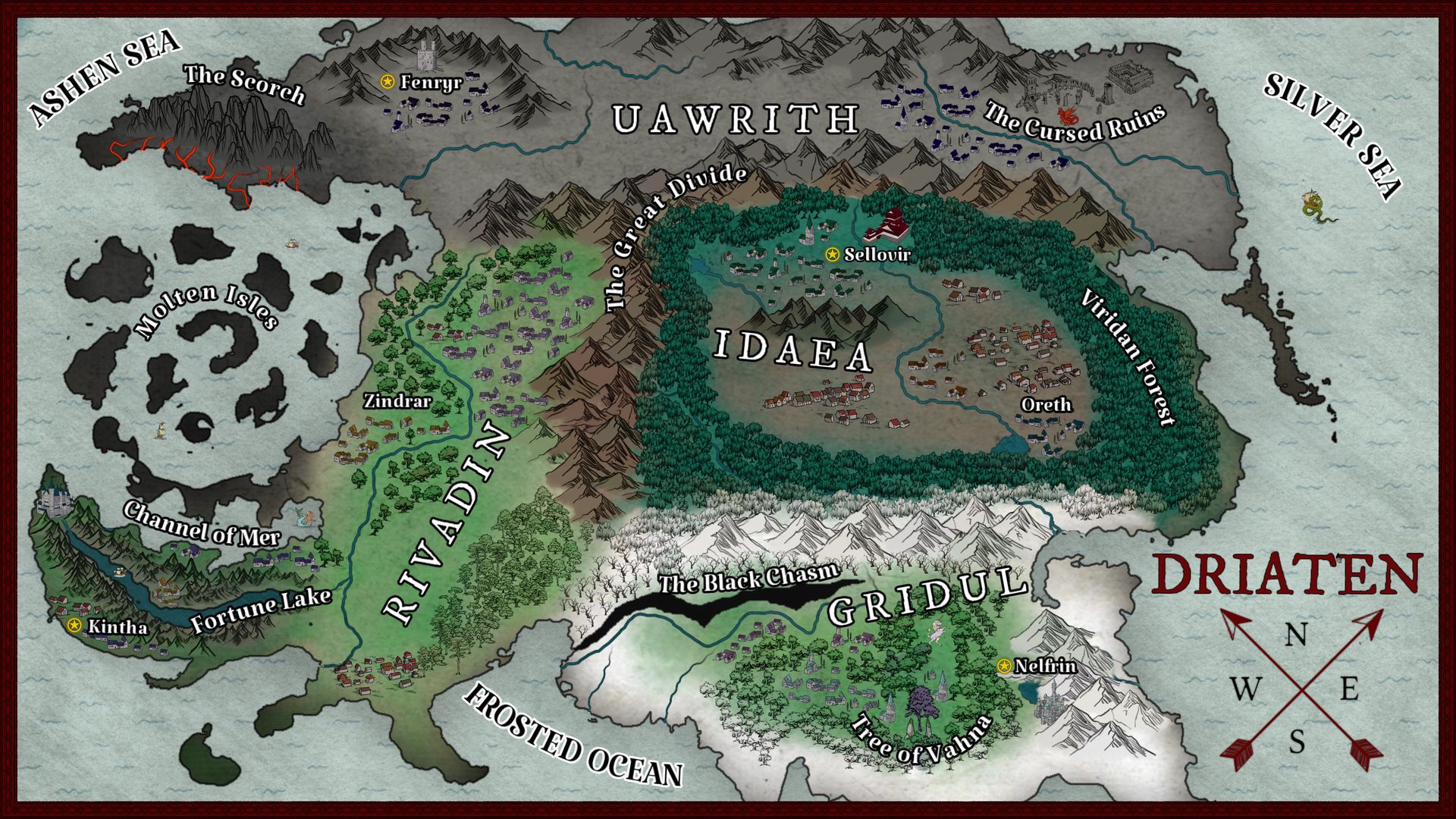mapping

MAPS!
Sorry, maps just make me so excited! I realize they can seem daunting to anyone who hasn't made one before, but maps are so important for fantasy writers. Even if you don't make a detailed one and you don't plan on sharing a map with your readers, you should still consider sketching one out for yourself. Maps help you keep track of where things are in your fictional world, which can help with things like travel time and sense of progression and realism within your plot. Keeping straight where places are located is important to keeping things consistent within your story. Even if the setting only involves a single castle or house, a sketch of the building's layout can help you describe things and navigate your readers better.
For this update, I'll review a few general "rules" to try to keep in mind as you go about mapping your world. If you've spent time thinking about physical, cultural, and magical aspects of your world, you should have an idea of what kinds of landmarks and cities you want to include. These will be important as you start shaping the continent(s) and marking different geographical details.
────── ・ 。゚☆: *.☽ .* :☆゚. ──────
1: Don't make your map bigger than it needs to be. You should only sketch out as much as the world as is relevant to the story you're telling. Of course, you can allude to the world being bigger in scope than what your characters explore, but your map doesn't really need to show every bit of the world's expanse. It will be easier for readers if your map is zoomed in on the boundaries within which your plot will take place. The smaller your scope, the more detailed your map can be because it has room to "zoom in". The larger your map, the less details you'll be able to fit on the map. How much land your map will show is completely up to you and the reaches of your story, whether it's a single village, one main continent, or an entire galaxy.
2. Use real geography as a reference. The more you understand about our own world's geography, the more realistic your map will be. For example, rain collects in mountains and rivers then start at mountains and run downhill until they reach the sea. Mountains come in chains, and usually the climate is different on either side of a mountain range due to winds and weather patterns. Separate continents usually are shaped like puzzle pieces that might've fit together at some point in history. Islands also tend to come in chains.
All this being said, you can of course make exceptions! Just try to provide some sort of magical reasoning for why something is unusual in your world to help readers better accept it.
3. Decide if you want to use color or not. If you plan on publishing your book, odds are you'll be stuck with blacks and whites. But for your personal use or online posting, you can choose to use a wider range of colors. Greens to show lusher lands, browns to show drier climates, or maybe even purples if your world is known for its violet trees. Whatever colors you choose, they can be used to give hints to the reader about what type of climates there are.
4. Ask yourself which details need to be shown. If your map is larger and zoomed out, you likely will only be able to show borders of different territories and their names. If your map has a smaller scope, you'll have more space to include details like trees, rivers, lakes, mountains, names of different towns, capitols, etc. Ultimately, how much or how little you show is up to you!
5. Consider what might help your map stand out from others. Whether it's the art style, the shape of your land, a unique landmark, etc., ask if there are any defining traits of your world that could be shown on the map to grab attention.
6. Keep history and politics in mind. Perhaps there was a natural disaster centuries ago that left a lasting mark on your world. Try to show that! If your story involves a lot of politics and different regions are at war, defining clear borders on your map becomes a lot more important. Always try to show the most relevant aspects of your world in your map if possible and forget the less important traits. You can show smaller details off through your actual writing!
7. Keep scale in mind. This is probably the hardest part to map making. None of the maps I've made so far have been very accurate when it comes to scale, and that is okay depending on the style and purpose of your map! But if you are aiming for a highly realistic map that shows exact distance between regions, you'll want to keep the scale of things like mountains, buildings, and trees in mind, as well as the length between territories. It won't make much sense if you say your map is 2,000 miles wide but then your trees are as big as the mountains should be.
8. Take your time! Don't rush your map. You can draft multiple sketches until you're happy with the shapes of your land(s), and you can work at it over time to make sure you're happy with how it's turning out. Of course, you'll want to spend less time if you don't plan on actually showing your map to the readers. Don't be afraid to ask people for feedback too.
9. Study real maps and other fantasy maps for inspiration! Take note of the shapes they use, what coastlines look like, how rivers tend to be shaped, etc. the more familiar you are with how maps should generally look, the easier of a time you'll have starting on your own!
────── ・ 。゚☆: *.☽ .* :☆゚. ──────
Now I'll show you guys an example of a map I made for one of my upcoming projects! Please DO NOT steal this or use the same details I've created (like specific landmarks, names, etc). I worked hard on it, despite it being far from perfect.


I created two different versions of this map to cover two different styles. I prefer the old-fashioned/worn look at the first one, but I liked having a second map with more details. The bottom map clearly reveals much more about the world than the first one, which may not be what some of you want if you aim to keep things more mysterious at the beginning of the book. It's totally up to you how much or little you decide to show!
I used the program called Wonderdraft to create these, but there are many options out there for you. Wonderdraft costs about $50 for a one-time purchase, which was worth it for me as I plan on mapping most of my future works. Inkarnate is another application I've seen many fantasy writers use. And of course you can always draw your maps by hand, too!
I recommend looking up tutorials for actual map-making software because they often have a bit of a learning curve. It's worth the time investment though, in my opinion (:
That's all for today. Please let me know if you have any questions. I'm always happy to respond!
Bạn đang đọc truyện trên: AzTruyen.Top